
Black Russian Terrier: Height and Coat Review
Clarifying the Black Russian Terrier’s size and coat standards, with expert insights on grooming, structure, and balance.
Home » Meet The Breeds » Black Russian Terrier

The Black Russian Terrier (BRT) is a large and robust working breed developed in the former Soviet Union for military and guard work. Known for its intelligence, courage, and loyalty, the breed excels in protection roles and thrives only in a home with an experienced handler who can meet the dog’s physical and mental needs.
Working
26 – 30 inches
80 – 130 pounds
10 – 12 years
| Country of Origin | Russia |
|---|---|
| Bred For | Security |
| Known For | Large Size, Courage, Intelligence, Trainability |
| Popularity | Moderate |
| Temperament | Calm, Intelligent, Fearless, Protective |
| Activities | Guarding, Conformation Shows, Dog Sports |
The Black Russian Terrier, also known as the “Black Pearl of Russia,” was developed in the 1940s and ‘50s by the Red Star Kennel, a Soviet military program aimed at creating a versatile working dog. The breed was designed to serve as a guard dog for military installations, prisons, and other sensitive areas, with the goal of producing a dog that was powerful, intelligent, and adaptable to harsh climates.
To achieve these traits, the Red Star Kennel utilized selective breeding, combining over 17 breeds to create the Black Russian Terrier. The primary contributors to the development of the BRT included the Giant Schnauzer, Rottweiler, Airedale Terrier, Newfoundland, and Caucasian Shepherd Dog. The Giant Schnauzer provided intelligence and a strong work ethic. The Rottweiler added strength and guarding instincts. The Airedale Terrier contributed agility and endurance. And the Newfoundland and Caucasian Shepherd Dog enhanced the breed’s size and adaptability to extreme weather.
By the 1950s, the breed’s development had progressed to the point where it had become standardized and was distributed to civilian breeders for further refinement. In 1958, the Black Russian Terrier was officially recognized by the Russian Ministry of Agriculture as a distinct breed. The dogs quickly gained popularity beyond military use, thanks to their versatility and suitability for roles such as search and rescue, police work, and personal protection.
The Black Russian Terrier was introduced to the United States and other countries in the late 20th century, where it gained recognition for its impressive working ability and striking appearance. The Fédération Cynologique Internationale (FCI) recognized the Black Russian Terrier in 1984, and the American Kennel Club (AKC) followed in 2004, placing the breed in the Working Group.
Male Black Russian Terriers stand between 27 and 30 inches tall at the shoulder, while females measure slightly less at 26 to 29 inches. They generally weigh between 80 and 130 pounds.
The Black Russian Terrier is a large, well-muscled dog with a balanced and powerful build that indicates both strength and endurance. The body is slightly longer than it is tall at a ratio of 9.5 to 10, with a deep chest and a strong, straight back. The appearance is sturdy and athletic, and general balance is more important than absolute size.
Texture: The Black Russian Terrier has a double coat that is dense and coarse, designed to protect the dog in harsh climates. The outer coat is rough and wiry, and varies in length from 1.5 to 6 inches, with a softer undercoat that provides insulation. The legs are covered with long, protective hair, and the head features distinctive facial furnishings, including a beard, moustache, and a fall over the eyes, which add much to the breed’s imposing appearance. The coat requires trimming to maintain a tidy appearance.
| Standard Color | |
|---|---|
| Black | y |
| Salt & Pepper | y |
| Black & Tan | y |
| Sable | y |
| Blue | y |
| Standard Marking | |
|---|---|
| Saddle Pattern | y |
A Note About Color: The only acceptable color for the Black Russian Terrier is black, or black with gray hairs. Any other color is unacceptable in the breed.
The tail of the Black Russian Terrier is set high and thick at the base. It is traditionally docked, leaving about three vertebrae, but in countries where docking is prohibited, the natural tail is long and carried in a slight upward curve when the dog is alert.
The Black Russian Terrier is a highly intelligent and protective breed best suited for experienced owners who can provide firm leadership and consistent training. These dogs thrive in active households with ample space, where their physical and mental needs can be met through exercise, training, and meaningful interaction.
The Black Russian Terrier is a generally healthy breed with a lifespan of 10 to 12 years. Maintaining good health requires regular veterinary care, a balanced diet, and sufficient exercise to support the dog’s robust build and active nature.
Although robust, individual Black Russian Terriers can be prone to certain health conditions, including:
The Black Russian Terrier is a confident, intelligent, and loyal breed known for its natural protective instincts. These dogs are deeply devoted to their families and are especially good with children when properly socialized.
While generally reserved with strangers, they are not overly aggressive and can typically distinguish between threats and normal situations. Early socialization, however, is essential to ensure they grow into well-mannered and adaptable companions, so they do best in homes where they receive consistent attention and training from the start.
The Black Russian Terrier requires a high-quality diet tailored to its size, age, and activity level. Adult dogs typically consume 3 to 4 cups of dry dog food per day, divided into two meals to prevent overeating and reduce the risk of bloat.
Puppies should be fed a diet formulated for large-breed growth, with meals divided into three to four portions daily to support steady development. Monitoring weight gain and adjusting food portions as needed helps to maintain a healthy condition overall, avoiding issues like obesity or joint strain.
Black Russian Terriers are highly intelligent and trainable but can be independent and strong-willed, requiring firm and consistent leadership. Positive reinforcement methods, such as treats and praise, work best to keep them engaged and motivated during training sessions.
Early training and socialization are critical to teaching appropriate behavior and ensuring comfort for the BRT in various environments. Due to the breed’s natural guarding instincts, these dogs need clear boundaries to prevent overprotectiveness. Likewise, ongoing mental stimulation through obedience exercises or canine sports is essential to keep them happy and content.
The Black Russian Terrier has moderate to high energy demands and requires daily exercise to stay physically and mentally healthy. These dogs benefit from long walks, playtime in a secure yard, and activities such as Obedience or Agility training to challenge their minds and bodies.
| Energy Level | Moderate to High |
|---|---|
| Exercise Requirements | 40 Minutes/Day (Minimum), Daily Walks, Vigorous Running, Regular Exercise, Mental Stimulation |
Without adequate exercise and stimulation, these intelligent dogs may become bored, which can lead to a variety of destructive behaviors. A minimum of 60 to 90 minutes of daily physical activity is recommended to meet their needs.
The Black Russian Terrier’s dense, double coat requires regular grooming to prevent matting and to keep it in good condition. Weekly brushing is sufficient for most of the year, but during seasonal shedding periods, more frequent brushing is necessary to manage the loose hair.
| Coat Type | Double, Moderately Wavy, Coarse |
|---|---|
| Grooming Requirements | Weekly Brushing, Occasional Bathing, Routine Ear Cleaning, Periodic Nail Trimming, Regular Tooth Brushing |
The coat needs occasional trimming, especially around the beard, eyebrows, and feet, to maintain the breed’s signature appearance. Regular nail trimming, ear cleaning, and dental care are also essential parts of the grooming routine.
The Black Russian Terrier thrives in a home with ample space and a securely fenced yard where the dog can move about freely and patrol the perimeter. These dogs are best suited for families who can provide structured training, consistent interaction, and plenty of mental and physical stimulation.
The BRT forms strong bonds with family members and does not tolerate long periods of isolation well, preferring to be actively involved in household activities. These are, however, adaptable dogs and can manage well in a variety of climates when given the proper care.
Black Russian Terrier puppies are intelligent and energetic, often displaying signs of their breed’s natural protective instincts. Early training and socialization are critical during puppyhood to help them grow into confident, well-mannered adults capable of distinguishing a normal interaction from a genuine threat.
Caring for a Black Russian Terrier puppy requires a structured routine that includes proper nutrition, consistent training, and regular veterinary care. A high-quality large-breed puppy food is essential to support rapid growth, with meals divided into three to four portions daily to prevent overfeeding and reduce the risk of bloat.
Training should begin as soon as the puppy arrives home, focusing on basic commands, housetraining, and leash manners. Positive reinforcement methods, such as treats and praise, work best for this intelligent and eager-to-learn breed. Socialization is equally important, exposing the puppy to a variety of people, animals, and environments to build confidence and reduce potential overprotectiveness.
Regular grooming sessions should start early to get the BRT puppy accustomed to brushing and trimming, especially around the face and paws. Veterinary check-ups during the first year are vital to monitor growth, administer vaccinations, and screen for any health concerns. Providing a balance of exercise, mental stimulation, and rest helps to ensure a healthy, happy, and well-adjusted puppy.
The Black Russian Terrier is recognized by the world’s leading registries and kennel organizations, which categorize the breed into a specific Group based on its unique characteristics. This breed is recognized worldwide under the following Group designations:
| Organization | Group Designation |
|---|---|
| AKC (American Kennel Club) | Working |
| UKC (United Kennel Club) | Guardian |
| CKC (Canadian Kennel Club) | Working |
| ANKC (Australian National Kennel Council) | Utility |
| RKC (The Royal Kennel Club) | Working |
| FCI (Fédération Cynologique Internationale) | Group 2: Pinscher and Schnauzer Type – Molossoid Breeds – Swiss Mountain and Cattle-Dogs; Section 1.4. Pinscher and Schnauzer |
The ideal Black Russian Terrier is described by a Breed Standard that is approved by each of the world’s leading registries and kennel organizations. The Breed Standards for this breed may be found in the following links:
| Organization | Breed Standard |
|---|---|
| American Kennel Club | AKC Black Russian Terrier Breed Standard |
| United Kennel Club | UKC Black Russian Terrier Breed Standard |
| Canadian Kennel Club | CKC Black Russian Terrier Breed Standard |
| Australian National Kennel Council | ANKC Black Russian Terrier Breed Standard |
| The Royal Kennel Club | RKC Black Russian Terrier Breed Standard |
| Fédération Cynologique Internationale | FCI Black Russian Terrier Breed Standard |
Yes, Black Russian Terriers shed minimally compared to many other breeds, but their dense coat does require regular grooming to prevent matting. Seasonal shedding is manageable with consistent brushing.
No, Black Russian Terriers are not hypoallergenic. While they shed less than some breeds, they still produce dander, which can trigger allergies in sensitive individuals.
Black Russian Terriers typically live between 10 and 12 years. Proper care, regular veterinary check-ups, and a balanced diet can help to support their longevity.
Yes, Black Russian Terriers can be excellent family dogs when properly trained and socialized. They are loyal, protective, and great with children, but their size and strength require supervision around small kids.
Black Russian Terriers are not excessive barkers, but they will bark to alert their owners to potential threats. Their barking is purposeful, reflecting the breed’s natural guarding instincts.

Clarifying the Black Russian Terrier’s size and coat standards, with expert insights on grooming, structure, and balance.

Powerful & protective, the Black Russian Terrier is a majestic breed with military roots, loyalty, and a need for strong guidance.
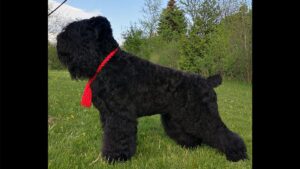
The Black Russian Terrier (BRT) excels in more than shows; it’s a versatile, loyal, and powerful working companion.

Explore the origins and evolution of the Black Russian Terrier, a versatile military breed developed for harsh climates.
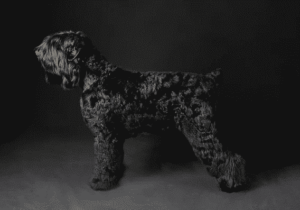
Why are Black Russian Terriers black? A Comprehensive look at the history of color and pigmentation of the Black Russian Terriers.
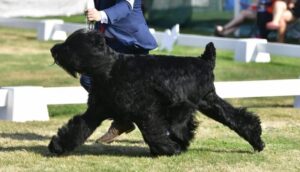
Read on to learn how the Black Russian Terrier breed is judged in the AKC conformation show ring. Judging size, proportion, and substance.
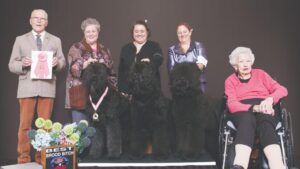
Kaye Shipley & Layne Shipley Townsend are the breeders behind ZolaRoza Black Russian Terriers. Read about the kennel’s beginnings & more!
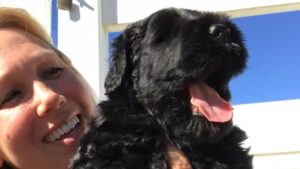
Dr. Christine Robinson is breeder behind Black Beard Black Russian Terriers. Read about the kennel’s beginnings, the puppies, and much more!
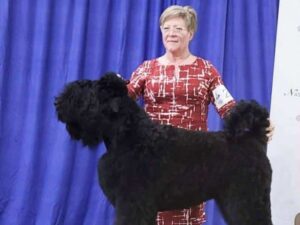
Kahla Johnson is the breeder behind Beautiful Black Russian Terriers of Iowa. Read about the kennel’s beginnings, the puppies, and much more!

Patty Bartley Shonts is breeder behind NAISSUR Black Russian Terriers. Read about the kennel’s beginnings, the puppies, and much more!
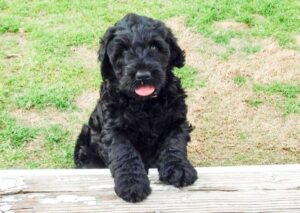
Christine Robinson is the breeder behind Black Beard Black Russians. Read about the kennel’s beginnings, champions, puppies, photos & more!
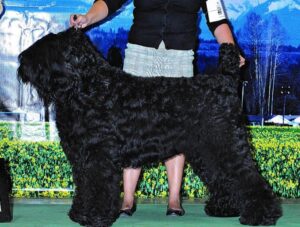
Lyla Morrell is the breeder behind Russia’s Royalty Black Russian Terriers. Read about the kennel’s beginnings, champions, puppies & more!
The best way to ensure a long and happy relationship with a purebred dog is to purchase one from a responsible breeder. Not sure where to begin?
Contact the National Parent Club’s Breeder Referral Program, which is listed on the AKC Breeder Referral Contacts page.

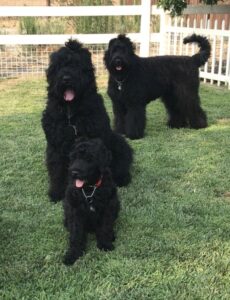
The Black Russian Terrier : A Picture of Health | in general, the Black Russian Terrier is a healthy, robust dog. Like many large breed dogs